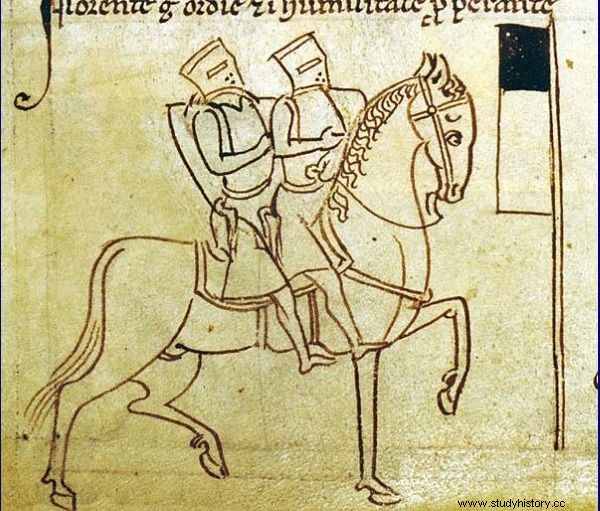Feeding pigs, pedigree for 16 generations back and ... punitive service on a galley. Not just anyone was accepted into the ranks of knightly orders. And some of the requirements were really peculiar.
The most important knightly orders have their roots in Jerusalem at the time of the Crusades. Christians from all over Europe had made pilgrimages to the Holy Land before, and the flow of travelers only increased when the Holy City was recaptured during the first Crusade (1096–1099). However, the success of the war against Muslims did not make expeditions to the Middle East simple and safe. In a place of religious zeal, travelers had very unpleasant adventures. The pilgrims were a tasty morsel for the local robbers, who, as Bertrand Galimard Flavigny writes in his book Joannici. History of the Order of Malta ” they prowled along the highways and dirt roads. Moreover, diseased Christians had to be cared for and, if necessary, healed.
All these tasks were performed by members of knightly orders. The brothers also fought the Saracens all the time, often dying on the battlefield and dying as a result of diseases they contracted in the Middle East. Nevertheless, not everyone was admitted to the waning ranks of orders.

Although over time they gained enormous wealth, the Templars adopted as their emblem two knights on one horse, who were to symbolize poverty.
Various vagabunds, all kinds of adventurers, nuns who had escaped from monasteries and dangerous criminals flocked to Jerusalem. All under the guise of repentance and seeking salvation, and in fact simply to avoid punishment or trouble in the homeland. Out of all that mess, suitable candidates had to be sifted out.
Pedigree was checked first
As reported by Bertrand Galimard Flavigny in the book Joannici. History of the Order of Malta ” , candidates wishing to join the ranks of the Knights Hospitaller had to prove their worth. During the crusades, it was to be evidenced primarily by nobility, the confirmation of which was to be provided by the candidate's family. In 1270, the rule was that:
the candidate should have "proved by incontrovertible evidence that he was indeed born into a noble family by name and coat of arms."
Future religious from Germany had to trace their ancestry up to 16 generations back. Others were in a slightly better position:for example, knights from France were only expected to have an 8-generation lineage. All of this took place in a genuine trial, including witness testimony and the presentation of evidence.
Then the will was broken
First of all, the candidate had to learn absolute obedience. There was an iron discipline in the Templar order. Edward Putkowski emphasizes in the book "Knights in habits" that it was a necessary condition to make a punitive and effective army out of a jumble of disheveled feudal lords, accustomed to feasts, drunkenness and all kinds of revelations. Many of the candidates were playful and disappointed in the ambitions of younger sons with no chance of taking over the schema and position of their parents.
To submit them to the will of the law, they had to be broken first. For example, the brothers did this by forcing the candidates to do things unworthy of a knight, such as feeding the pigs or grinding flour in a mill. Every act of disobedience was severely punished, for example by flogging, imprisonment or forced fasting. The worst thing, however, was the possibility of being removed from the ranks of the order.
They were finally tried in battle
Members of the knightly orders were primarily to defend the Christian religion with a blade in their hand. Therefore, among other things, they were not bound by harsh fasts practiced by monks. After all, a knight had to be well fed to have the strength to swing his sword in battle and carry monstrously heavy armor.

"The Siege of Accra." Master of the Knights Hospitaller Mathieu de Clermont defends the city walls.
The Joannites took care, in particular, of checking the candidates for the maritime service. After the fall of the Kingdom of Jerusalem, knights moved from horses to ships, and therefore knights suffering particularly badly from seasickness would not be a support for the order in battle. In addition to caring for the sick, which was one of the important tasks of the Knights Hospitaller, the candidates had to prove themselves on board. Bertrand Galimard Flavigny in the book Joannici. History of the Order of Malta ” writes:
In Malta, Grand Master Martin Garzes (1595-1601) decided that each knight should complete "four caravans", or periods of compulsory service of embarking four times, for four years in a row, in one of the Order's seven galleys.
They finally took their vows
When the brothers decided that the candidate was worthy to join their militant congregation, it was time to take vows. Before this happened, however, the young man had to confess all his sins in order to become part of the law as a new man. He listened to mass, took communion, and only then made oaths.
When he entered the knightly order, he did not have to be a monk-priest, but he vowed, like many adepts of monasticism, to poverty, obedience and chastity. However, members of the knightly orders had to promise something else - that they would defend their faith, even if it meant in practice the merciless eruption of the Saracens, as they collectively called all Muslims.
